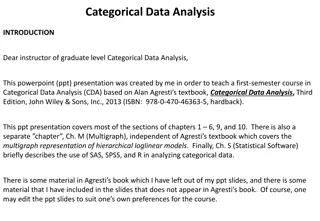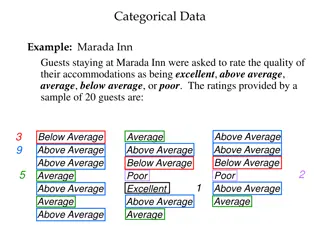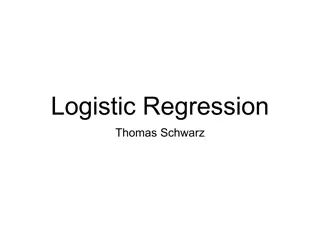Visualizing Categorical Data in Data Analysis
Explore methods for displaying and describing categorical data effectively, from frequency tables to bar and pie charts. Understand the importance of visual representation in drawing insights and making comparisons. Dive into examples using football team data and Titanic survivors. Learn to identify relationships between categorical properties and interpret results.
Download Presentation

Please find below an Image/Link to download the presentation.
The content on the website is provided AS IS for your information and personal use only. It may not be sold, licensed, or shared on other websites without obtaining consent from the author.If you encounter any issues during the download, it is possible that the publisher has removed the file from their server.
You are allowed to download the files provided on this website for personal or commercial use, subject to the condition that they are used lawfully. All files are the property of their respective owners.
The content on the website is provided AS IS for your information and personal use only. It may not be sold, licensed, or shared on other websites without obtaining consent from the author.
E N D
Presentation Transcript
Lecture 2 Displaying and describing categorical data
Make a picture Large tables are inconvenient: we see many many rows, but can not observe anything (see next slide)
It has about 100 rows
Make a picture In the previous table, what if we wanted to see proportion of freshmen/sophmores/juniors/seniors in the Commodores football team? We would have to draw a chart. Chart should make our eye immediately capture differences between proportions.
A frequency table We first summarize the table we have into a shorter one Freshmen 34 25 30 14 Sophmores Juniors Seniors
Freshmen 34 25 30 14 Sophmores Juniors Seniors This table is still a bit too hard. We can, of course, compare 4 numbers. But what if we had more rows? Say, ages 0 2, 2 4, 4 6, and so on. Or the numbers are large: compare 10123248 to 10123419.
A bar chart Chart Title 40 35 30 25 20 15 10 5 0 FR SO JR SR
A pie chart Count FR SO JR SR
And many more! Just open MS Word and hit Insert chart Chart Title 40 Why this one is bad? 35 30 25 20 15 10 5 0 FR SO JR SR
Exploring the relationship A single football player has two categorical properties : say, year of study and position? We want to know: are they related or independent ? I.e., if one is a senior, can we confidently say that, most probably, he is not a wide receiver?
Lets switch to the book: Titanic survivors First Class 203 Second Class 118 Third Class 178 Crew Total Alive 212 711 Dead 122 167 528 673 1490 Total 325 285 706 885 2201 Let s identify the who sand the what s. Can we now say that someone from the first class had more chances to survive?
First Class 203 Second Class 118 Third Class 178 Crew Total Alive 212 711 Dead 122 167 528 673 1490 Total 325 285 706 885 2201 The bad thing is that we see too much. We see that 203 1st class passengers survived versus 178 from the 3rd class. But then we look down and see 325 vs 706
First Class 203 Second Class 118 Third Class 178 Crew Total Alive 212 711 Dead 122 167 528 673 1490 Total 325 285 706 885 2201 First Class 62% Second Class 41% Third Class 25% Crew Alive 24% Dead 38% 59% 75% 76% Instead of Alive + Total we now have only one number to compare
Conditional distributions We can do, for example, this: how many alive passengers were in the first class? In the second class? And so on. Mathematically we ask: what is the proportion of survivors CONDITIONED to the fact that they are in the first class?
We get the following table First Secon d 118 16.6% Third Crew Total 203 28.6% 178 25% 212 29.8% 711 First column reads: 203 out of 711 survivors were from the first class. Or: 28.6% of all survivors were from the first class
Rule of thumb The rule of thumb is: we have a table with certain property as row (alive/dead) and certain property as column (class). We then restrict ourselves to one particular column or row. Say, how does the survival % differ for different classes? This means that we care only about survivors; thus, so we condition to the fact that one survived.
Bar chart again We express survivor percentages depending on class 70 60 50 40 30 20 10 0 First Second Third Crew
One more bar chart And here is a side-by-side chart of survivors vs nonsurvivors 76 75 62 59 41 38 25 24 FIRST SECOND THIRD CREW
76 75 62 59 41 38 25 24 FIRST SECOND THIRD CREW We (almost) see that the survival chance DEPENDS on the class. If all conditional distributions (conditioned to what?) were the same, we would say that survival chances and class are INDEPENDENT
Homework Read chapter 2. Work through examples and carefully read the what can go wrong section Do p.33+: 1, 4, 5, 6, 17, 31, 34, 37bce, 41abd























